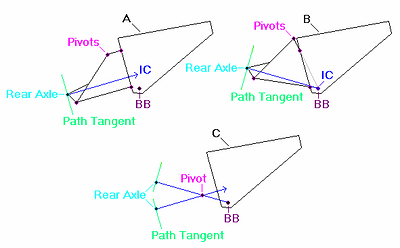
Figure 3.10)
Click to enlarge
A) Mono-Pivot and 4-Bar Rear Axle Paths.
4-bar rear axle paths can deviate from those of conventional mono-pivots in three different ways:
First, mono-pivot paths will always be circular about the main pivot. 4-bars can have varying path curvature. The easiest way to see this is to consider Figure 3.10 A). Draw the complete circular path of the upper rear pivot as the upper link rotates about the upper front pivot. Next, consider the path of the lower rear pivot, as the upper rear pivot goes through its revolutions. This lower pivot will move back and forth along a circular arc. By “‘Nature Varies Smoothly' (NVS).”, we see that the paths of points along the rear link will be much like the upper link circle for points close to the upper link, and much like the lower link arc for points close to the lower link. The paths will gradually change from one to the other as the points vary along the rear link. An axle mounted somewhere in between will have varying path curvature.

Figure 3.10)
Click to enlarge
At the moment, the “The Virtual Pivot Point (VPP).” concept, conceived by Outland and soon to be re-introduced by Santa Cruz and Intense, is unique among viable concepts in its capability to produce significantly variable curvature. However, as we will see, current examples do not take any real advantage of the possibilities.
Secondly, conventional mono-pivots do not have main pivots located within the wheel radius. This limits the minimum radius of axle path curvature to at least the size of the rear wheel.
A mono-pivot could achieve a tighter curvature only if the pivot were split into right and left. We have proposed such a bike, which we call the “split-pivot mono”. This design is in fact viable and will have the added benefit of a more stable pivot. Figure 3.10 C) shows the tight curvature. We thus do not consider tight curvature to be an inherent advantage of 4-bars over mono-pivots, since the split-pivot mono can achieve the path. Although no such bikes are in current production, the split-pivot mono was the motivation behind Cannondale's new Scalpel.
4-bars can achieve a tightly curved path centered inside the rear wheel radius. Figures 3.10 A) and B) show a 4-bar with the same tangent as our split-pivot mono both at equilibrium and compression. We have achieved our example by having the IC move backward as it moves down. This is essentially the Giant NRS design. The Rocky Mountain ETS-X70 also uses a linkage system to create a center of curvature inside the wheel radius.
And thirdly, mono-pivots will always have pivots located within the body of the bicycle frame. 4-bars can achieve a more widely curved path, as is the case in the current “Virtual Pivot Point (VPP).” designs.